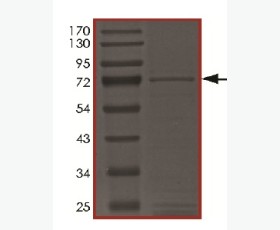Recombinant Human Vascular Non-Inflammatory Molecule 1/Vanin-1/VNN1
| Product name: | Recombinant Human Vascular Non-Inflammatory Molecule 1/Vanin-1/VNN1 |
| Source: | Human Cells |
| Purity: | Greater than 95% as determined by reducing SDS-PAGE. |
| Buffer Formulation: | Lyophilized from a 0.2 μm filtered solution of 20mM PB, 150mM NaCl, pH 7.2. |
| Applications: | Applications:SDS-PAGE; WB; ELISA; IP. |
| Storage: | Avoid repeated freeze/thaw cycles. Store at 2-8 oC for one month. Aliquot and store at -80 oC for 12 months. |
| UOM: | 100ug/50ug/200ug/1mg/1g |
| Source | Human Cells |
| Description | Recombinant Human Vascular Non-Inflammatory Molecule 1 is produced by our Mammalian expression system and the target gene encoding Gln22-Ser490 is expressed with a 6His tag at the C-terminus. |
| Names | Pantetheinase, Pantetheine Hydrolase, Tiff66, Vascular Non-Inflammatory Molecule 1, Vanin-1, VNN1 |
| Accession # | O95497 |
| Formulation | Lyophilized from a 0.2 μm filtered solution of 20mM PB, 150mM NaCl, pH 7.2. |
| Shipping |
The product is shipped at ambient temperature. |
| Reconstitution |
Always centrifuge tubes before opening. Do not mix by vortex or pipetting. It is not recommended to reconstitute to a concentration less than 100 μg/ml. Dissolve the lyophilized protein in ddH2O. Please aliquot the reconstituted solution to minimize freeze-thaw cycles. |
| Storage |
Lyophilized protein should be stored at < -20°C, though stable at room temperature for 3 weeks. Reconstituted protein solution can be stored at 4-7°C for 2-7 days. Aliquots of reconstituted samples are stable at < -20°C for 3 months. |
| Purity |
Greater than 95% as determined by reducing SDS-PAGE. |
| Endotoxin | Less than 0.1 ng/µg (1 IEU/µg) as determined by LAL test. |
| Amino Acid Sequence |
QDTFTAAVYEHAAILPNATLTPVSREEALALMNRNLDILEGAITSAADQGAHIIVTPEDAIYGWN FNRDSLYPYLEDIPNPEVNWIPCNNRNRFGQTPVQERLSCLAKNNSIYVVANIGDKKPCDTSDPQ CPPDGRYQYNTDVVFDSQGKLVARYHKQNLFMGENQFNVPKEPEIVTFNTTFGSFGIFTCFDILF HDPAVTLVKDFHVDTIVFPTAWMNVLPHLSAVEFHSAWAMGMRVNFLASNIHYPSKKMTGSGIYA PNSSRAFHYDMKTEEGKLLLSQLDSHPSHSAVVNWTSYASSIEALSSGNKEFKGTVFFDEFTFVK LTGVAGNYTVCQKDLCCHLSYKMSENIPNEVYALGAFDGLHTVEGRYYLQICTLLKCKTTNLNTC GDSAETASTRFEMFSLSGTFGTQYVFPEVLLSENQLAPGEFQVSTDGRLFSLKPTSGPVLTVTLF GRLYEKDWASNASSVDHHHHHH
|
| Background | Vanin-1 is a cell membrane protein which contains one CN hydrolase domain and belongs to the CN hydrolase family and BTD/VNN subfamily. Vanin-1 is also a member of the Vanin family of proteins, which share extensive sequence similarity with each other, and also with biotinidase. The family includes secreted and membrane-associated proteins, a few of which have been reported to participate in hematopoietic cell trafficking. Vanin-1 is widely expressed with higher expression in spleen, kidney and blood and overexpressed in lesional psoriatic skin. No biotinidase activity has been demonstrated for any of the vanin proteins; however, they possess pantetheinase activity, which may play a role in oxidative-stress response. Vanin-1 is an epithelial pantetheinase that provides cysteamine to tissue and regulates response to stress. Vanin-1 is expressed by enterocytes, and its absence limits intestinal epithelial cell production of proinflammatory signals. Vanin-1 regulates late adhesion steps of thymus homing under physiological, noninflammatory conditions. The early impact of vanin-1 deficiency on tumor induction was directly correlated to the amount of inflammation and subsequent epithelial proliferation rather than cell death rate. Vanin-1 molecule was shown to be involved in the control of thymus reconstitution following sub-lethal irradiation. |
| References |
Spry C,et al.Pantothenamides Are Potent, On-Target Inhibitors of Plasmodium falciparum Growth When Serum Pantetheinase Is Inactivated PMID:23405100 http://www.ncbi.nlm.nih.gov/pubmed/23405100 |














